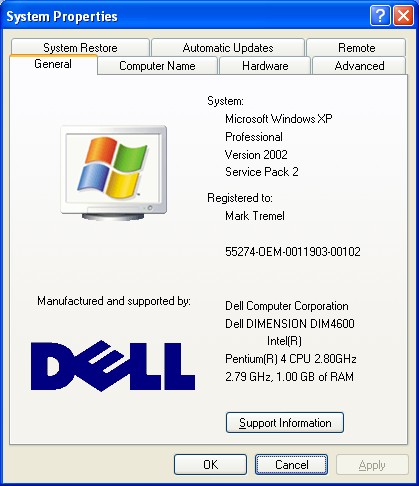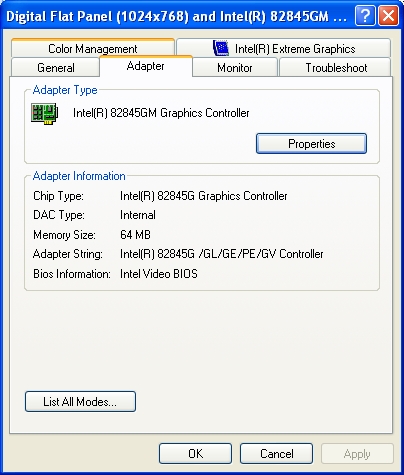Tech Support
Welcome to E.T. Technology's Tech Support. On this page I present a sort of FAQ or Q&A of common problems people have with their computers and how to usually fix them. Just look to see if one of the questions matches something you've said recently, and my answer might help solve your problem without paying $100 an hour for professional computer repair. Just know that simce I'm not actually looking at your computer, none of this is guaranteed to help and is just an estimated fix for a general situation.
"My computer is running really slow - it takes forever to do anything! How can I speed it up?"
There are several ways to speed up a computer that is running slowly, depending on the situation. First, check how much RAM you have compared with the operating system and level of programs you're running. In Windows you can find out how much RAM your computer has installed by looking at the System Properties dialog (Control Panel -> System). Generally, if you're running Windows 98 or 2000 you should have at least 128 MB of RAM, and if you're running Windows XP you should have at least 256 MB. But if you plan on running newer programs, especially games, you need 512 MB to function well and a gigabyte (1024 MB) is best. When buying RAM, make sure you get at least the same "speed" RAM as your computer already has - for example, if the documentation you got when you bought it lists "256 MB 400MHz SDRAM," you should make sure the RAM you buy is at least 400MHz (it should say on the package) or else it will cause the rest of the RAM to slow down to its speed. Along similar lines, you can have poor performance even with a good amount of RAM if you don't have a video card or the one you have is inadequate for the program you're running. A computer without a video card (that is, you plug the monitor directly into the motherboard) has to "borrow" memory from the system's RAM to store graphics processing information, so with a graphics-intensive program (usually a game like Doom 3) you won't have enough RAM (even with 512 MB) for both the graphics and the game itself. A video card, on the other hand, has onboard RAM that is used just for graphics processing, so the system RAM won't have to be "shared" unless the graphics needs more than the video card provides. Video cards are usually denoted by the amount of onboard RAM they have as well as the make and model (i.e. "128 MB ATI RADEON 9800"), so it's pretty easy to know how much graphics memory a card comes with when you're buying it. Most people need a 64 MB to 128 MB video card, but for high-graphics games like Doom 3 you will probably need a 256 MB one. To check if you have a video card installed (and find out how much memory it has), go to your Display Properties (right-click on deskop -> Properties), click Advanced, and go to the Adapter tab.
Generally, if you're running Windows 98 or 2000 you should have at least 128 MB of RAM, and if you're running Windows XP you should have at least 256 MB. But if you plan on running newer programs, especially games, you need 512 MB to function well and a gigabyte (1024 MB) is best. When buying RAM, make sure you get at least the same "speed" RAM as your computer already has - for example, if the documentation you got when you bought it lists "256 MB 400MHz SDRAM," you should make sure the RAM you buy is at least 400MHz (it should say on the package) or else it will cause the rest of the RAM to slow down to its speed. Along similar lines, you can have poor performance even with a good amount of RAM if you don't have a video card or the one you have is inadequate for the program you're running. A computer without a video card (that is, you plug the monitor directly into the motherboard) has to "borrow" memory from the system's RAM to store graphics processing information, so with a graphics-intensive program (usually a game like Doom 3) you won't have enough RAM (even with 512 MB) for both the graphics and the game itself. A video card, on the other hand, has onboard RAM that is used just for graphics processing, so the system RAM won't have to be "shared" unless the graphics needs more than the video card provides. Video cards are usually denoted by the amount of onboard RAM they have as well as the make and model (i.e. "128 MB ATI RADEON 9800"), so it's pretty easy to know how much graphics memory a card comes with when you're buying it. Most people need a 64 MB to 128 MB video card, but for high-graphics games like Doom 3 you will probably need a 256 MB one. To check if you have a video card installed (and find out how much memory it has), go to your Display Properties (right-click on deskop -> Properties), click Advanced, and go to the Adapter tab.  If a brand (usually ATI or NVidia) and model number of video card are listed, it means you have a graphics card and "memory size" will be the amount of RAM it has. If "adapter" says something weird like "Intel 84825GM Graphics Controllor," it probably means you're using integrated graphics and "memory size" is the amount of system RAM that's being "borrowed" for graphics use.
If a brand (usually ATI or NVidia) and model number of video card are listed, it means you have a graphics card and "memory size" will be the amount of RAM it has. If "adapter" says something weird like "Intel 84825GM Graphics Controllor," it probably means you're using integrated graphics and "memory size" is the amount of system RAM that's being "borrowed" for graphics use.
Another reason why a computer could be running slowly is the presence of spyware, adware, malware, viruses, Trojan Horses, etc.. These programs run "hidden" in the background, taking up processing cycles and RAM space while doing something subversive, such as stealing your personal information, tracking your browsing habits, serving pop-up advertisements, and even destroying data on your hard drive. Many people surf around downloading stuff from various websites without bothering to check the site's reputation, not realizing that most "free" products are actually vehicles for tricking you into downloading such a program. If you are in the habit of downloading "free" programs and you don't have a virus scanner, firewall, and spyware scanner on your computer, chances are it's running slow because of malicious programs. While it is sometimes impossible to regain control of your computer once these programs have installed themselves, most of the time you can get your computer mostly clean once you are aware of the problem. To remove spyware and other harmful programs, I suggest taking the following steps:
- Go to the add/remove programs control panel (Start -> Control Panel -> Add/Remove Programs) and look at the list of installed programs. Uninstall anything with "ad" or "deal" or "coupons" (etc.) in its name - sometimes adware programs do allow themselves to be removed if you make the effort to do so. Restart your computer if necessary.
- Download Lavasoft Ad-Aware SE Personal from this page and install it on your computer.
...
(page under construction)
